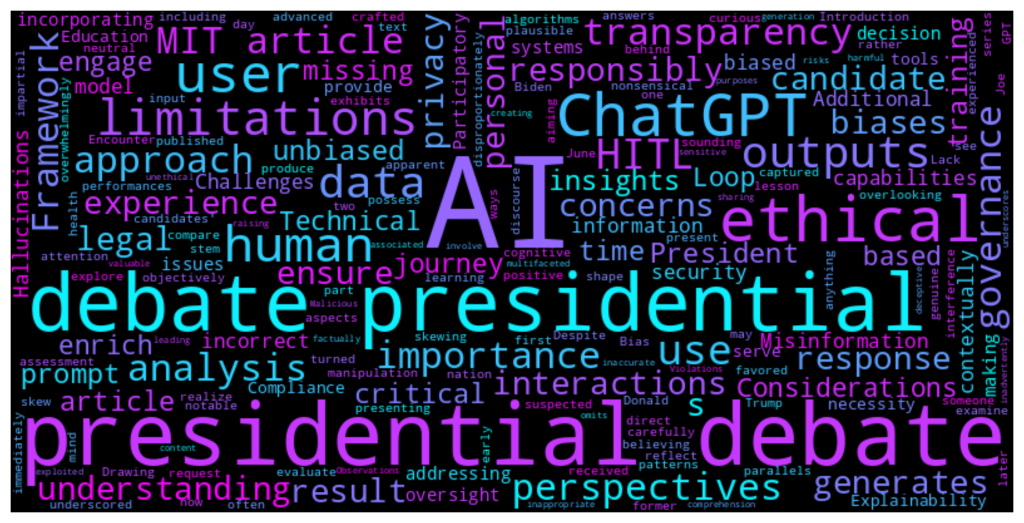
On June 27, 2024, the first presidential debate between President Joe Biden and former President Donald Trump captured the nation’s attention. A day or two after the debate, I turned to ChatGPT for an analysis of the candidates’ cognitive health, curious to see how AI would evaluate their performances. My prompt was carefully crafted to be neutral and unbiased, aiming to compare both candidates objectively. However, the response I received was anything but impartial.
The AI’s analysis disproportionately favored one candidate, presenting an overwhelmingly positive assessment while overlooking critical aspects of the other. At the time, I suspected human interference, believing that someone behind ChatGPT was skewing the data. Only later did I realize that such biases are not the result of direct manipulation but rather stem from the training data and algorithms that shape AI outputs. This personal experience underscored the importance of understanding AI’s limitations and the need for ethical oversight in its use.
With this lesson in mind, I now explore the insights from the MIT article, “The Limitations and Ethical Considerations of ChatGPT,” published in early 2024. Drawing parallels to my own journey of learning how to engage with AI responsibly, I also examine the importance of the Human-in-the-Loop (HITL) approach and other missing perspectives that could enrich the discourse on ethical AI interactions.
The Limitations and Ethical Considerations of ChatGPT
Technical Framework and Limitations
ChatGPT, as part of the GPT series, generates human-like text based on input prompts. Despite its advanced capabilities, it exhibits notable limitations, including:
- Hallucinations: The model can produce plausible-sounding but incorrect or nonsensical answers, as I experienced in my request for an unbiased analysis of the presidential candidates.
- Biases: AI outputs often reflect the biases present in their training data, which can skew results in ways that may not be immediately apparent to users.
- Lack of Understanding: ChatGPT generates responses based on patterns in its data but does not possess genuine comprehension, leading to contextually inappropriate or factually incorrect outputs.
Ethical Challenges
The ethical concerns associated with ChatGPT are multifaceted:
- Misinformation: The generation of biased or inaccurate information, as in my experience with the presidential debate analysis, underscores the risks of misinformation.
- Privacy Violations: AI interactions could inadvertently involve sharing sensitive information, raising concerns about data security and user privacy.
- Malicious Use: AI could be exploited for unethical purposes, such as creating deceptive or harmful content.
Additional Observations: Missing Perspectives
While the MIT article provides valuable insights, it omits several critical concepts and approaches that are highly relevant to the ethical use of ChatGPT:
- Human-in-the-Loop (HITL):
The HITL approach emphasizes incorporating human oversight in AI decision-making processes to ensure outputs are accurate, ethical, and contextually appropriate. HITL can prevent issues like biased responses or hallucinations by allowing human reviewers to catch and correct errors in real time. - Participatory AI Governance:
A more inclusive approach to AI governance is essential, involving diverse stakeholders from various sectors. This ensures that AI systems are developed and deployed with a broad range of perspectives, addressing concerns related to fairness, equity, and cultural relevance. - Transparency and Explainability:
Users need to understand how AI generates its outputs. The importance of transparency—making AI operations understandable—and explainability—clarifying why a model generated specific results—is paramount for building trust and accountability. - Regulatory Frameworks and Legal Compliance:
The MIT article does not delve into the role of legal frameworks in guiding ethical AI use. Governments and organizations must establish clear policies to govern AI’s deployment, addressing issues like privacy, data security, and misuse. - User Education and Awareness:
The article overlooks the necessity of educating users about AI’s capabilities and limitations. By fostering AI literacy, users can make informed decisions, question outputs, and responsibly interact with AI systems.
Conclusion
My experience with ChatGPT during the 2024 presidential debate highlighted the importance of understanding AI’s limitations and adopting strategies like the HITL approach. While the MIT article effectively outlines ChatGPT’s technical and ethical challenges, incorporating these additional perspectives—transparency, participatory governance, legal compliance, and user education—can enrich the conversation and provide a more comprehensive framework for ethical AI use.
As AI tools become increasingly integrated into our daily lives, maintaining ethical and responsible use is not just a recommendation but a necessity. By combining technological advancements with human oversight and governance, we can navigate the complexities of AI interactions and ensure that these tools serve as a force for good.
This article serves as both a reflection on my personal journey and a call to action for AI users to engage responsibly, keeping ethics and transparency at the forefront.